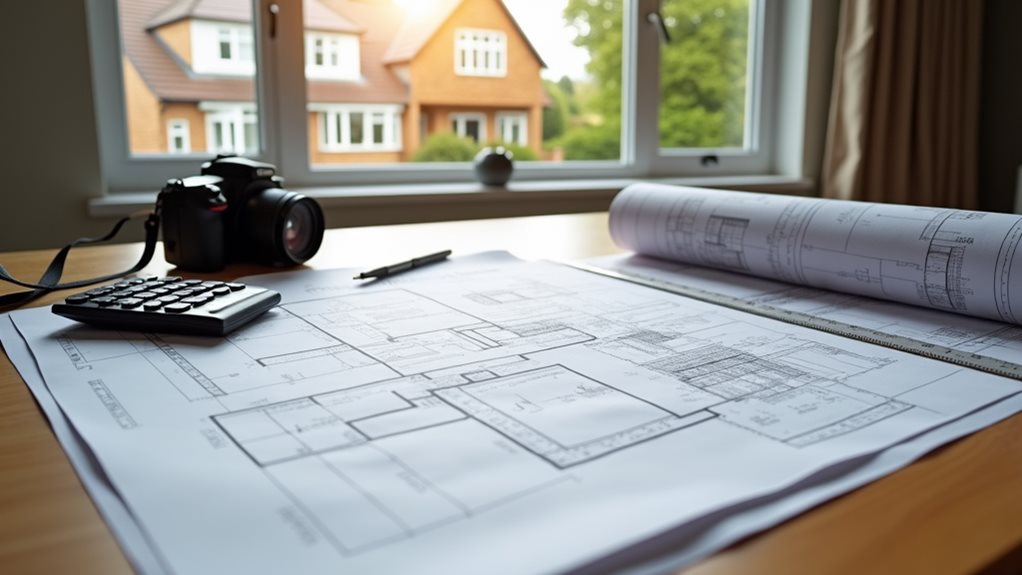Phone:
(701)814-6992
Physical address:
6296 Donnelly Plaza
Ratkeville, Bahamas.

Discover essential planning permission rules for home extensions - from permitted rights to conservation restrictions that could affect your project.
You'll need to understand both permitted development rights and full planning permission requirements for your extension project. While permitted development allows certain changes without council approval, size restrictions apply: up to 6m for semi-detached and 8m for detached homes. You'll face stricter rules in conservation areas or with listed buildings, and you must meet specific energy efficiency standards. Working with planning professionals can help navigate local regulations and boost your approval chances, setting you up for a deeper understanding of the process.

When it comes to extending your property in the UK, understanding permitted development rights can save you significant time and money during the renovation process. These legal implications are particularly important as they determine whether you'll need formal planning permission for your extension project.
You'll be pleased to know that permitted development rights allow you to make certain changes to your home without seeking council approval. This includes single-storey extensions, loft conversions, and even adding a front porch. Additionally, many homeowners are unaware that expert builders can provide valuable assistance in navigating these rights.
Thanks to the Larger Home Extension Scheme, you can now build extensions up to 6 meters for terraced or semi-detached homes and 8 meters for detached properties without full planning permission. However, you'll need to be aware of specific restrictions, especially if your property is in a conservation area or you're planning larger alterations.
While flats and maisonettes don't benefit from these rights, most houses do, making it easier for you to enhance your living space within the prescribed limits.
You'll need to carefully consider your extension's dimensions, as permitted development rights limit the size to no more than half your property's original land area.
For semi-detached homes, you're allowed extensions up to 6 meters without planning permission, while detached houses can extend up to 8 meters.
When planning your extension's location, remember it can't be closer to public roads than your existing house walls, and you'll need to maintain specific height requirements, including a maximum eaves height of 2 meters at the boundary. The extension must match the existing house in terms of visual materials used to maintain architectural consistency.
Understanding the maximum area rules for home extensions represents a vital first step in your planning process, as these regulations directly impact the scope and feasibility of your project.
When calculating your maximum extension limitations, you'll need to guarantee your plans don't exceed 3 meters beyond the rear wall for attached properties or 4 meters for detached homes.
Additionally, it's important to remember that your extension area calculations must account for all buildings on your property, which together can't cover more than half of your original land area.
For single-storey extensions, you're restricted to half the size of your original house, while side extensions mustn't increase your home's width by more than 50%.
These requirements help maintain neighborhood aesthetics while allowing you to expand your living space effectively.
Three critical distance requirements govern the placement of your home extension in relation to property lines.
You'll need to comply with your local setback regulations, which typically mandate 5-15 feet of clearance, observe any no-build zones, and respect utility easements.
Getting these measurements right from the start helps you avoid costly property line disputes later.
Before breaking ground, you'll want to confirm your property's exact boundaries through official surveys and review your municipality's zoning codes.
Many homeowners face setback violations simply because they didn't double-check their measurements.
Remember, you're not alone in this process – your local Building and Safety office can guide you through the requirements, and maintaining open communication with your neighbors often prevents future complications.
Always obtain necessary permits before beginning construction.
When planning a home extension, strict height and length restrictions serve as essential guidelines that will shape your project's dimensions.
For single-storey rear extensions, you'll need to work within specific height limitations, with a maximum height of 4m and eaves height of 2m if you're building within 2m of your boundary.
Extension lengths vary depending on your property type. If you've got a detached house, you can extend up to 8m from the rear wall, while attached houses are limited to 6m.
These measurements change to 4m and 3m respectively if you're on designated land.
Remember that your extension can't be taller than your existing house, and the roof pitch should match your current property.
You'll also need to guarantee the materials match your home's exterior appearance.
Building extensions in conservation areas and on listed buildings demands careful attention to specialized regulations that go far beyond standard planning requirements.
As a property owner, you'll need to navigate strict conservation guidelines that protect the area's character and appearance. Most alterations, even minor ones, require planning permission due to Article 4 directions that limit permitted development rights.
If you're dealing with a listed building, you'll need separate listed building regulations approval alongside standard planning permission.
Your extension must preserve the building's historic significance and character, with careful consideration given to materials and design. You'll find that even small changes, like exterior cladding or roof modifications, require explicit permission.
Remember that unauthorized work can result in criminal charges, so it's crucial to seek pre-application advice before proceeding.

When you're planning an extension, you'll need to guarantee it meets strict building regulations that cover core safety requirements, including structural integrity, fire protection, and ventilation standards.
Your project must also comply with current energy performance requirements, which specify minimum standards for insulation, window efficiency, and heating systems.
The structural design rules are particularly essential, as they'll determine everything from your foundation depths to the size of supporting beams.
You'll need detailed calculations from a qualified professional to demonstrate compliance.
Before initiating any extension project, you'll need to navigate the vital framework of building regulations and compliance standards that safeguard both your property and its occupants.
Your extension must meet strict safety standards across multiple elements, including structural integrity, drainage, and electrical systems.
You'll find that compliance checks occur at critical stages of construction, ensuring everything from your windows to your external walls meets required specifications.
When you're planning your extension, remember that approved inspectors or local authorities will verify your work through regular inspections.
These safeguards aren't just bureaucratic hurdles – they're designed to protect you and future occupants.
Non-compliance can lead to serious consequences, including hefty fines or even mandatory demolition, so it's important to get these fundamentals right from the start.
Modern extensions must adhere to strict energy performance standards that help minimize environmental impact while keeping your energy bills manageable.
As a homeowner, you'll need to guarantee your project meets specific requirements for energy efficiency and performance assessment.
Key requirements you'll need to meet include:
You can demonstrate compliance through either the Standard Assessment Procedure (SAP) or area-weighted U-value calculations.
If you're planning a conservatory that's heated or connected to your home's heating system, you'll need to meet these same standards, as exemptions won't apply.
Three fundamental pillars form the backbone of any extension's structural design: safety, compliance, and durability.
When you're planning your extension, you'll need to guarantee its structural integrity meets building regulations through careful material selection and professional oversight.
You'll want to work with a structural engineer who'll calculate load-bearing requirements and design essential elements like foundations, beams, and roof rafters.
Your extension's materials should match your existing house while meeting local building codes.
Don't forget that you'll need either a Full Plans application or Building Notice before starting work, and you'll have regular inspections throughout the build.

When you're ready to apply for planning permission, understanding the formal application process will help guarantee a smoother journey through the local authority's review system. Your submission requirements include detailed site plans, proposal documentation, and supporting materials that demonstrate your project's compliance with local regulations.
The standard application timeline typically follows these key stages:
You'll want to make certain your application addresses potential environmental impacts and aligns with sustainable development principles.
Working with professionals like architects or environmental consultants can greatly improve your chances of success, as they'll help you navigate ecological considerations and local planning policies effectively.
Beyond securing planning permission, thoughtful design choices shape the success of your extension project. When considering extension aesthetics, you'll want to make certain your addition seamlessly blends with your existing home while incorporating modern elements that enhance its value and functionality.
To maximize design flexibility, consider installing bi-folding doors and internal glazing that create flowing spaces and welcome natural light.
You'll need to think about practical matters too – from storage solutions during construction to furniture placement in your completed space.
Whether you're opting for a rear extension or a more ambitious wraparound design, remember to plan for the future. Consider features like level thresholds and adaptable spaces that'll serve your needs as they evolve, while maintaining strong connections to outdoor areas through strategic window placement.

Successfully managing the planning permission process depends heavily on your interactions with planning professionals. When you're working on your extension project, effective planning communication is essential for maneuvering the system smoothly.
You'll want to develop strong extension strategies that account for potential delays and department limitations.
Here are key points to remember when working with planning departments:
Building an extension doesn't just affect your property – it impacts your entire neighborhood and local community.
You'll need to carefully consider how your plans might influence the area's character, local wildlife habitats, and your neighbors' quality of life.
During the planning process, you'll find that community feedback and neighbor consultations play a significant role. Your local planning authority will notify nearby residents, giving them the opportunity to voice any concerns about privacy, noise, or visual impact.
You'll want to address these issues proactively by ensuring your extension is proportionate to your existing property and doesn't overshadow neighboring homes.
Remember that maintaining good relationships with your neighbors throughout the process isn't just courteous – it's vital for a smooth approval process and harmonious community living.
Successfully steering through the planning permission process isn't rocket science, though you'll need more than a horse and buggy to get there. You're now equipped with essential knowledge about permitted development rights, size requirements, and regulatory compliance. By understanding these requirements, working effectively with professionals, and maintaining positive neighbor relations, you'll be well-positioned to transform your extension plans from blueprints to reality while staying within legal boundaries.